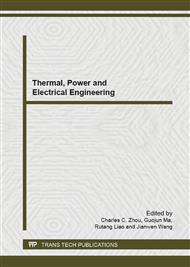[1]
Chen Shuyong, Song Shufang, Li Lanxin, and Shen Jie, Survey on smart grid technology, Power System Technology, Vol. 33, No. 8, 2009, pp.1-7(in Chinese).
Google Scholar
[2]
Lu Qiang, Qi Xiaoyao, He Guangyu, Smart grid and smart wide area robot, Proceedings of the CSEE, Vol. 31, No. 10, 2011, pp.1-5(in Chinese).
Google Scholar
[3]
Chi Yongnin, Liu Yanhua, Wang Weisheng, Chen Mozi, Dai Huizhu, Study on impact of wind power integration on power system, Power System Technology, Vol. 31, No. 3, 2007, pp.77-81(in Chinese).
DOI: 10.1109/icpst.1998.729318
Google Scholar
[4]
Ni Yixin, Theory and Analysis of Dynamic Power System, 1st Edition. Tsinghua University Press, 2002(in Chinese).
Google Scholar
[5]
P. Kundar, Power System Stability and Control, 1st Edition, McGraw-Hill, (1994).
Google Scholar
[6]
Zhufang, Zhao Hongguang, Liu Zenghuang, Kou Huizhen, The influence of large power grid interconnected on power sytem dynamic stability, Proceedings of the CSEE, Vol. 27, No. 1, 2007, pp.1-7(in Chinese).
Google Scholar
[7]
Wang Jiaming, Liu Wenying, Niu Shuanbao, Study on damping characteristics of Xinjiang-Northwest power grid before and after interconnection, Power System Protect and Control, Vol. 38, No. 16, 2010, pp.92-98(in Chinese).
DOI: 10.1109/appeec.2010.5448320
Google Scholar
[8]
Li Dahu, Cao Yijia, An online identification method for power system low-frequency oscillation based on fuzzy filtering and prony algorithm, Automation of Electric Power System, Vol. 31, No. 1, 2007, pp.14-19(in Chinese).
DOI: 10.1109/icpst.2006.321622
Google Scholar
[9]
Zhoumi, Low frequency oscillation simulation research of south China power grid, North China Power University, 2008(in Chinese).
Google Scholar
[10]
Li Guihong, Small signal stability analysis of power system connected wind farm, Taiyuan University of technology, 2010(in Chinese).
Google Scholar
[11]
Liu Chunmei, Liyong, Xinyang, Study on Influencing Factors of Low Frequency Oscillation of Power System, Shaanxi Electric Power, Vol. 39, No. 6, 2011, pp.12-15(in Chinese).
Google Scholar
[12]
Yan Changyou, Zhou Xiaoxin, Tian Fang, Yan Jianfeng, Online identification of dominant characteristic modes of small signal disturbance and selection of strong correlative units, Power System Technology, Vol. 33, No. 13, 2009, pp.42-47.
Google Scholar


